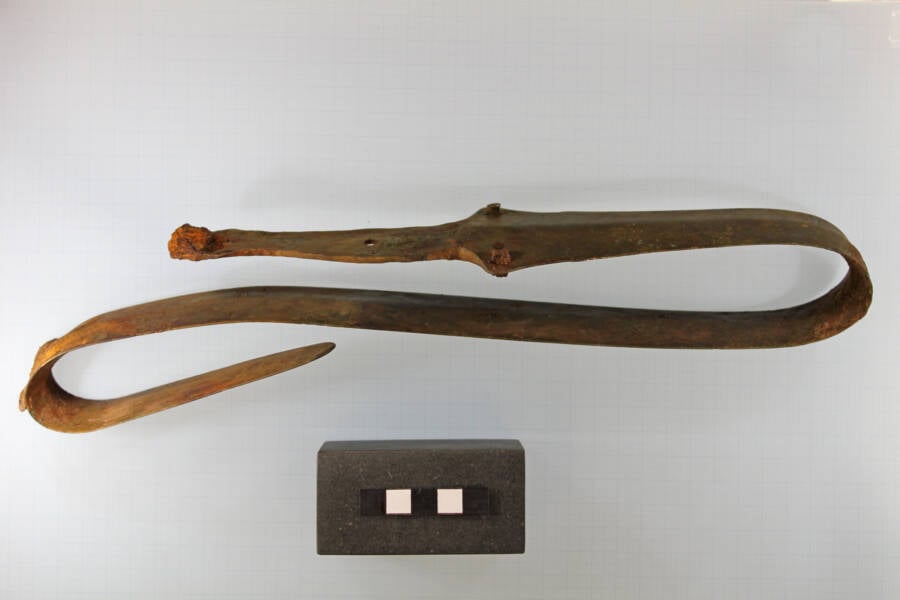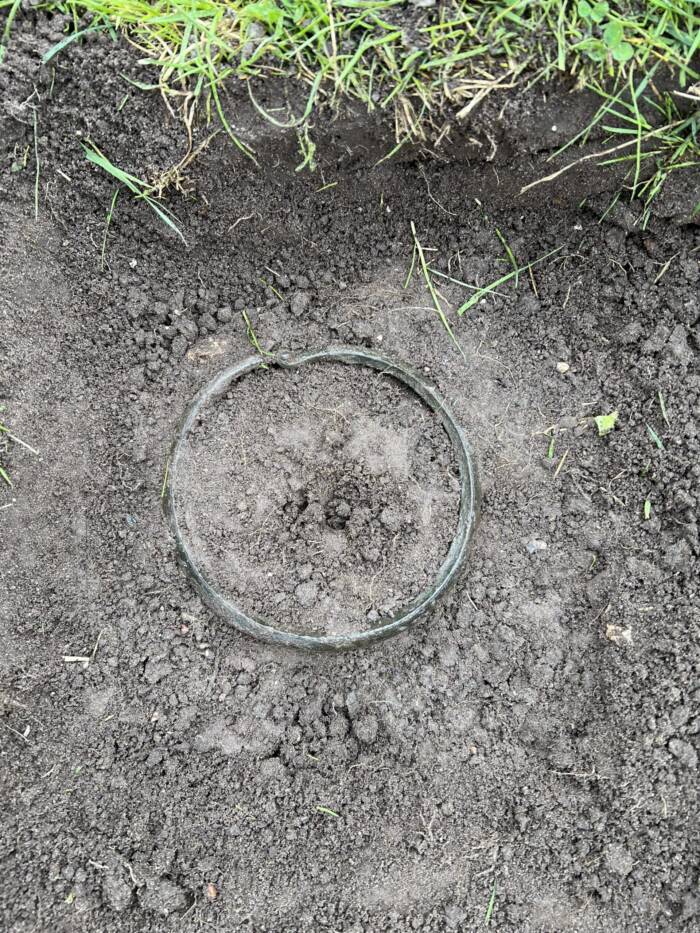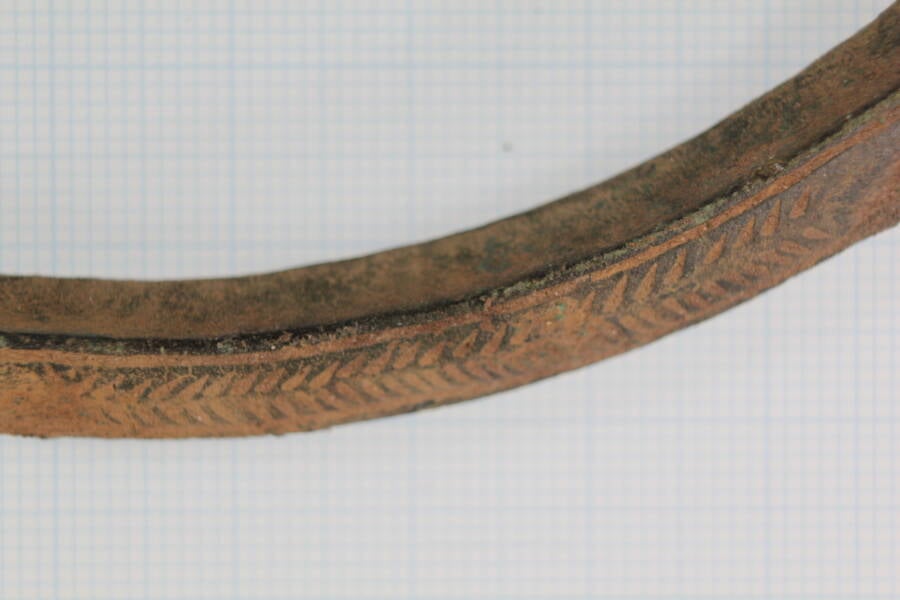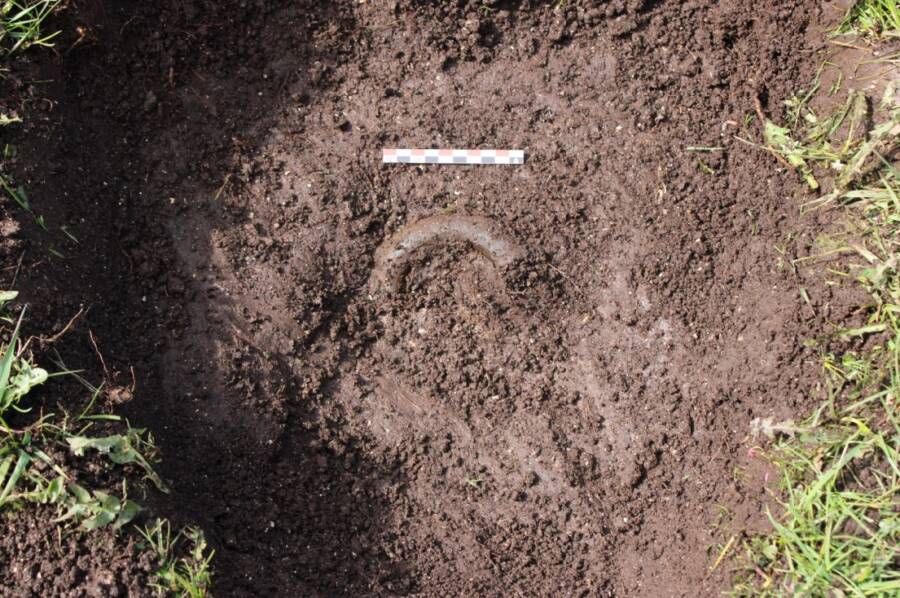A first-time metal detectorist found a cache of objects dating back to 500 B.C.E. in a bog near Veksø, including a sword, several rings, and two axes.

ROMUThis S-shaped sword was ritualistically bent to render it ineffective as a weapon and instead provide symbolic value as a sacrificial offering.
In the spring of 2024, an amateur metal detectorist made a stunning discovery at a bog near Veskø, Denmark on his very first outing. He uncovered a cache of various 2,500-year-old artifacts, including a sword bent into an “S” shape as part of an ancient ritual.
Upon making the discovery, the metal detectorist contacted the museum organization ROMU to analyze the discovery, and they’ve described the find as exceedingly rare.
A First-Time Metal Detectorist Discovers A 2,500-Year-Old Sword In A Danish Bog
Earlier this year, a first-time metal detectorist named Claus Falsby set off into a bog just west of Copenhagen, Denmark, hoping to find something of value. However, Falsby could never have guessed just how valuable his find would be.
As he walked through the boggy Værebro Ådal conservation area, his metal detector picked up something just below the surface. Upon digging, he uncovered a bronze sword with iron rivets, two small axes, three ankle rings, a fragment of a large pin, and another mysterious, unidentified object.
Days later, roughly 230 feet away, he also found a bronze neck ring.

ROMUA neck ring that was found roughly 230 feet from the initial discovery.
Wanting to know more about the history behind his finds, he contacted the museum organization ROMU, which sent the archaeologist Emil Winther Struve to analyze the find.
“This is what I would describe as a very rare find,” Struve said in a translated statement. “From the first and middle part of the Bronze Age, we have a lot of these deposit finds where bronze objects appear in the bogs. But we don’t know that many from the last part of the Bronze Age.”
The phrase “deposit find” is of particular note here. According to Struve, a deposit find is essentially a group of objects buried in honor of some ancient god in a ritualistic manner. The sword was of special interest as well, due to its unique shape.
How A Ritualistically Bent Sword Represents An Era Of Change In Ancient Denmark
The sword was bent into the shape of an “S” before it was buried, a ritual practice for votive offerings. The iron rivets on the sword are among the earliest known in Denmark, dating to 500 B.C.E., and the sword itself seems to have been imported from the northern Alps region, influenced by the Hallstatt culture that flourished there.

ROMUA close-up of the intricate details of the neck ring.
“The Hallstatt culture spread rapidly, characterized by a warrior ethos with an emphasis on conquest and conflict,” Struve said. “Their swords were sturdier, heavier, and more suitable for slashing rather than stabbing, reflecting a shift in combat techniques.”
Because it was ritualistically bent, the sword was no longer an effective weapon, but its fine craftsmanship and materials would have made it a valuable sacrifice nonetheless. Moreover, its uselessness as a weapon was believed to only enhance its symbolic value as an offering.
“We don’t have that many of these swords in Denmark,” Struve said. “It could be exciting to do analyses of both the bronze and the iron and find out exactly where it is produced… It is unusual for the iron rivets in the handle to be so well preserved, so it will be nice when the National Museum’s experts have finished its conservation.”

ROMUAn ankle ring found alongside the sword and other artifacts.
Overall, this discovery reflects a period of change in Denmark’s ancient history, when the new technologies and traditions of the Iron Age started to replace those of the Bronze Age. As Struve notes, this sacrificial tradition had once been more prevalent, but by the end of the Bronze Age, it was “on retreat.”
This region has long proven to be a valuable source of Bronze Age artifacts. In 1851, 163 early Bronze Age artifacts were found at Smørumovrefund, and in 1942, researchers found the famous Veksø helmets from the middle Bronze Age in the Brøns bog.
Now, this new discovery made by an amateur metal detectorist joins the ranks of some of the region’s most important historical finds.
After reading about this ancient sword, learn all about Denmark’s famous Tollund Man. Then, learn about bog bodies and the fascinating history behind them.





